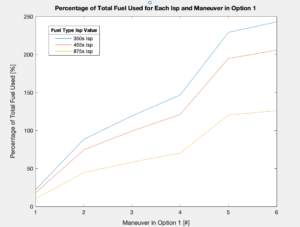MATLAB Plots & Comments
Hello everyone!
This past week I finished all of the fuel calculations, and we have reached Eris!! Unfortunately, after the percentages of total fuel used for each maneuver are added up, all of the options require more than 100% of the fuel. This is mostly due to the assumptions that were made in the calculations. Because of the time constraints and difficulty of the topic, I’ve had to use simpler techniques that are still accurate, but don’t account for everything, such as the energy gained from the rotation of the planets. Focused on finding ways to minimize this fuel consumption, I’ve begun researching a fly-by option at Jupiter which would eliminate the Jovian Capture Orbit thrust maneuver as well as researching other types of fuel with higher Isp (a measure of how effective a fuel is) values.
While working on finding more trajectory options, I created some tables in MATLAB to display the data I had already found. The plot below shows how the percentage total fuel used increases for each maneuver and isp for option 1- using Jupiter as the rendezvous planet. I made a plot like this one for the Mars option as well.

The most difficult part was creating the matrix for the plot. The thrust calculations were done for each maneuver in previous sections, but many of them account for the different rendezvous capture orbit eccentricity options (0.1, 0.2, 0.3…1) and isp’s, outputting a 10×3 matrix. Since I’m creating a line graph, each point can only have one fuel percent (y) value for each maneuver (x) per isp value. The code below shows the y-value matrix which only uses the minimum fuel percentage value from each section for each isp making each maneuver a 1×3 matrix (3 y-values for every 1 x-value).

In addition to plotting, I’ve gone through all of the code and added comments. A percentage sign starts a comment (green letters). Commenting the code is very important in order to make it legible and understandable to anyone viewing it. It also helps us to keep track of how each algorithm is used.
I’ll be working on the fly-by option and going up to Embry-Riddle in Prescott this week to start working on the simulation with STK-10 as well. Thanks for reading!
